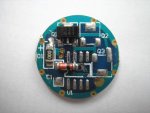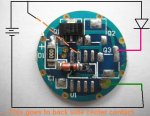Benm
0
- Joined
- Aug 16, 2007
- Messages
- 7,896
- Points
- 113
I prefer a soldered-in 1 ohm shunt for most applications as long as i can permit the voltage drop one causes at that point. The 20A range is very useful for measuring total current though, especially in flashlight contstructions where you can use it to bypass the tailcap (switch).
About the ground thing: it would be nice to have a similar chip that goes in the positive end. For most builds is just very convenient to have the diode mounted to ground. When building green laser drivers the 7135 is good since those are mostly case-positive devices.
About the ground thing: it would be nice to have a similar chip that goes in the positive end. For most builds is just very convenient to have the diode mounted to ground. When building green laser drivers the 7135 is good since those are mostly case-positive devices.








